hi guys . just wondering , since paraline loading is very effecient in hf drivers.
>>>> can paraline loading be used in unity horn or synergy horn tweeters like in danleys gh60
Paraline loading is no more efficient than a conical horn.
The purpose of a Paraline is to reduce vertical dispersion to only a few degrees without requiring a long throat, not what one normally wants in a Unity/Synergy horn.
Paralines are useful for combining HF driver output, a home use Unity/Synergy only needs one HF driver, a Paraline increases the build complexity, and makes the frequency response more ragged.
Member
Joined 2003
The ragged frequency response is probably the result of some sound reflecting back towards the throat at the three bends in the path, the 180 degree bend being more problematic than the two 90 degree bends.What is the root cause of the ragged FR?
The reflected sound waves cause some cancellation, resulting in narrow band dips.
The response looks worse on paper than it sounds, but there is no reason to use a Paraline throat adapter unless a very narrow vertical HF dispersion or multiple drivers on one horn is needed.
Member
Joined 2003
Paraline loading is no more efficient than a conical horn.
The purpose of a Paraline is to reduce vertical dispersion to only a few degrees without requiring a long throat, not what one normally wants in a Unity/Synergy horn.
Paralines are useful for combining HF driver output, a home use Unity/Synergy only needs one HF driver, a Paraline increases the build complexity, and makes the frequency response more ragged.
I'll agree that a conical horn will generally be flatter. I do not agree that they have no place in the home. If anything, I think a Paraline is a much more attractive option for home use than a synergy or unity horn, because the depth is so shallow. For instance, it's possible to make a Paraline that plays down to 100hz that's only 1.25" deep. (As long as you're willing to live with a Paraline that is very wide and tall.)
Paralines seem like a no-brainer if you're running a flat screen TV and you want all the good things that a Unity horn offers.
Having said that, I *do* agree that a plain ol' Unity or Synergy horn will have flatter response and better polar response. But at the cost of a large and clunky enclosure.
In my living room, I could live with a 1.25" deep Paraline, but I couldn't live with a loudspeaker that looks like this:
Then again, I don't have as much space as I used to (downsized into a smaller home) and if I had space to burn, I might have a different opinion on Paralines.
The ragged frequency response is probably the result of some sound reflecting back towards the throat at the three bends in the path, the 180 degree bend being more problematic than the two 90 degree bends.
The reflected sound waves cause some cancellation, resulting in narrow band dips.
The response looks worse on paper than it sounds, but there is no reason to use a Paraline throat adapter unless a very narrow vertical HF dispersion or multiple drivers on one horn is needed.
Hmmm, normally we agree, but I disagree with this.
Besides offering narrow dispersion, the Paraline is also insanely shallow. It's possibe to get the depth of the horn under 1"!
That's quite attractive in an age of flat screen TVs. It's also compelling for people with small homes, who can't justify organizing their entire living room around a set of speakers.
I'd say the #1 reason my Gedlee Summas are sitting in my garage is because they're too darn big. They sound great, but I don't want them dominating my whole living room.
Also, the Paraline has narrow dispersion in only one axis. This can be very nice if you build a big Paraline. For instance, it's possible to build a Paraline that has very narrow vertical directivity and very wide horizontal directivity. This is a really nice combination, similar to what the Keele CBT offers.
Patrick,Besides offering narrow dispersion, the Paraline is also insanely shallow. It's possibe to get the depth of the horn under 1"!
Also, the Paraline has narrow dispersion in only one axis.
I'd say the #1 reason my Gedlee Summas are sitting in my garage is because they're too darn big.
A 1" deep Paraline would have no horizontal pattern control, it would be a diffraction device, a little better than using no horn at all perhaps, other than the narrow vertical dispersion at high frequencies would not correlate well to the ultra wide horizontal dispersion.
The narrow dispersion in only one axis is frequency dependent, not constant directivity.
A Paraline offering the same horizontal control as your Summa horns would be the same width and depth.
Art
Last edited:
The entrance and exit are beveled at 45 degree (ideally a parabolic curved 45 degree), the "eye shaped" turn is 180 degree. I sanded off the "knife edge" in that turn in my Paralines, but it is still basically a square turn around through a 1/4" slot.Narrow HF is the attraction.
Do the current implementations use abrupt square 180 directional changes or are they internally beveled at 45 degrees?
For really high SPL use, the shortness of the Paraline compared to other "plane wave" (narrow vertical response) radiators is a good feature, as it comparatively reduces throat distortion.
Distortion can be far more objectionable than ragged frequency response, but again, a conical horn will have less throat distortion than a Paraline.
Patrick,
A 1" deep Paraline would have no horizontal pattern control, it would be a diffraction device, a little better than using no horn at all perhaps, other than the narrow vertical dispersion at high frequencies would not correlate well to the ultra wide horizontal dispersion.
The narrow dispersion in only one axis is frequency dependent, not constant directivity.
A Paraline offering the same horizontal control as your Summa horns would be the same width and depth.
Art
ugh I hate arguing with Art, because my arguments never make any sense, and his are succint.
FWIW, here's how I see it:
Art is right, a Paraline that's 1" deep has no horizontal pattern control. But that isn't necessarily A Bad Thing. The baffle of the Paraline will restrict radiation to 180 degrees. (All baffles are waveguides; they're simply waveguides that are 180 degrees, versus the 90 degree waveguides that we're accustomed to, such as the ones sold be Gedlee.)
So, yes, you're right. There's no horizontal pattern control. But the baffle takes care of that for us.
The narrow vertical directivity is a big feature. Personally, I would prefer to have narrow vertical directivity, and horizontal directivity which is wider. Which is what the Paraline offers.
The diffraction question is trickier. I'm not convinced that diffraction at the 180 degree bend will be audible. Basically the dimensions are so small that the only diffracted waves will be above 10khz, where I'm fairly certain it will be inaudible. Diffraction at the exit of the Paraline is a trickier question. I can see that it may occur at the exit. It's a tough question, because measuring diffraction is not trivial.
Patrick,ugh I hate arguing with Art, because my arguments never make any sense, and his are succint.
FWIW, here's how I see it:
Art is right, a Paraline that's 1" deep has no horizontal pattern control. But that isn't necessarily A Bad Thing. The baffle of the Paraline will restrict radiation to 180 degrees.
So, yes, you're right. There's no horizontal pattern control.
The narrow vertical directivity is a big feature.
Any speaker mounted on a flat baffle has 180 degree dispersion up to the piston diameter determined beaming frequencies.
If you like the high frequency vertical beaming of a Paraline, why not just use an 8" "full range" driver which offers uniform HF beaming
I'll again ask the question you never answered from post #56, have you compared your "Squarealine" output to the same speaker with no horn?
Other than a more narrow pattern at upper frequencies (perhaps) boosting on axis response, is the sensitivity increased broadband?
Art
Ok, so I ran another test to see the individual FR of the original paraline used in the array. Both single paralines show the bumps. The 3/16 paraline shows extended HF. 3/16 router bit vs 1/4 router bit.
Also, the interaction between the paralines in the array is lowering the HF and bringing up the mids. I don't have any experience with arrays so I can't explain what may be happening. What happens to the phase as you go from the the center of the slot to the ends?
I see a couple things here:
1) The response of one Paraline has some peaks and dips
2) The response of four Paralines is smoother in general, but has more output at lower frequencies and less output at high frequencies
IMHO, as the wavelengths get longer/lower, the Paraline is starting to sum properly, and that's why the measurement of four Paralines shows more output down low. At high frequencies, due to the short wavelengths, they're not summing properly.
I think that leaves a few options:
1) Curve the array, a la the Keele CBT. This reduces interference between the units, particularly since their beamwidth is so narrow.
2) power taper the array, for the same reason
3) modify the geometry of the Paraline so that the wavefront converges a bit, instead of being flat. Be careful with this though, as it may introduce more problems than it solves.
IMHO, simply curving the array, then using some EQ to bring up the top end, is the way to go. Very similar to what Keele is doing. Since most speakers are displacement limited, increasing the top end should be pretty easy, since it doesn't take a whole lotta excursion to make 15khz
Patrick,
Any speaker mounted on a flat baffle has 180 degree dispersion up to the piston diameter determined beaming frequencies.
If you like the high frequency vertical beaming of a Paraline, why not just use an 8" "full range" driver which offers uniform HF beaming?
I'll again ask the question you never answered from post #56, have you compared your "Squarealine" output to the same speaker with no horn?
Other than a more narrow pattern at upper frequencies (perhaps) boosting on axis response, is the sensitivity increased broadband?
Art
The reason that an 8" Paraline is superior to an 8" full range is that the 8" full range beams on the X and the Y axis, and the Paraline only beams on one.
I work in software, and as the salesmen like to say, "that's not a defect that's a feature!"
An 8" full range has a beamwidth that collapses as frequencies increase. Basically it's got a wide beamwidth down low, and a narrow beamwidth up high. An 8" Paraline has similar beamwidth on one axis, but wide beamwidth on the other. I really think this is pretty darn awesome because in the home that's exactly what we want. Wide beamwidth to light up the room horizontally, narrow beamwidth to reduce reflections off the ceiling and the floor vertically.
As for the response of my Squaraline, I junked that a few months back I'm afraid.
Yes, there's so many weird mounting arrangements you can do with a Paraline.
I'm pretty tempted to give this one a try, since the driver cost is under $200 per channel:
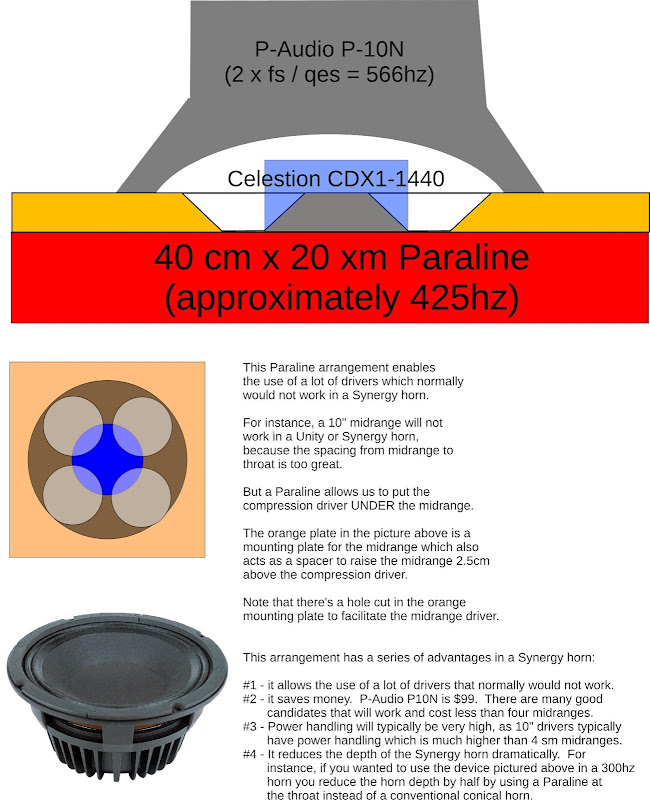
Basically, this is a coaxial arrangement with the compression driver UNDER the cone of the midrange driver.
This allows us to use a TON of additional midranges, potentiall raises power handling, etc.
It just occurred to me, you could go REALLY nuts and nest a compression driver in a midrange in a woofer :O
In a post a few weeks back, I raised the possibility of using a coaxial arrangement of the midrange and the tweeter on a Paraline. At the time, the only obvious candidates were large midranges, like the 8" from B&C. This is because there aren't too many compression drivers that will fit inside the cone of the woofer.
But those ribbon tweeters that another poster is using really open up some options. These things are small enough that they'll easily fit under the cone of nearly any woofer.
Note that you don't want to do this with a dome tweeter, because the cone shape is all wrong. A Paraline is a horn, and like any horn, it likes a flat wavefront at the apex. These ribbon tweeters aren't perfect, but they're likely a better match than a dome. A compression driver is even better, but a compression driver isn't small enough to pull off this hat trick
I see a couple things here:
1) The response of one Paraline has some peaks and dips
2) The response of four Paralines is smoother in general, but has more output at lower frequencies and less output at high frequencies
IMHO, as the wavelengths get longer/lower, the Paraline is starting to sum properly, and that's why the measurement of four Paralines shows more output down low. At high frequencies, due to the short wavelengths, they're not summing properly.
I think that leaves a few options:
1) Curve the array, a la the Keele CBT. This reduces interference between the units, particularly since their beamwidth is so narrow.
2) power taper the array, for the same reason
3) modify the geometry of the Paraline so that the wavefront converges a bit, instead of being flat. Be careful with this though, as it may introduce more problems than it solves.
IMHO, simply curving the array, then using some EQ to bring up the top end, is the way to go. Very similar to what Keele is doing. Since most speakers are displacement limited, increasing the top end should be pretty easy, since it doesn't take a whole lotta excursion to make 15khz
Patrick,
The ParaCBT idea is a good one, saving lots of $$ on tweeters. But CBTs are very hindered by the power tapering + curve. Legendre tapering takes 3dB off of sensitivity immediately. Curving the CBT introduces a 10dB/decade loss starting at the point that the line length + curve introduce pattern control, which can easily reach below 1000Hz. This can mean EQ boosts of up to 20+dB if not thought out well. People may run out of amp if they are using AVR power. The saving grace is that most program material exhibits a natural roll off in the higher frequencies, from what I have measured, helping to mitigate the power need up high for a CBT design.
JSS
It just occurred to me, you could go REALLY nuts and nest a compression driver in a midrange in a woofer :O
2*Fs/Qes for that woofer?
This thread slowed down so I figured I'd post some progress. The 4" Celestions showed up the other day, and the horn shell and Paraline itself have been built for a while. I was pretty stoked when these showed up, now I can see if this damn thing actually works!
Mid response/no eq 4ms gate about 6ft distance:

I'm looking for about 250-1.5khz bandwidth on the mids, not bad for the first shot. I figured I'd hit the 1.5k but would be lacking on the low end. Gotta work on the ports.
Comp driver response/no eq 4ms gate:
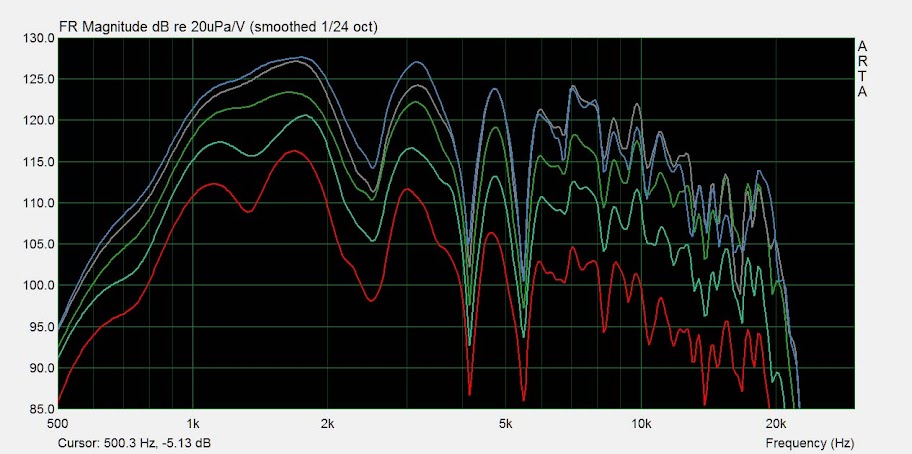
Pretty ugly! After all my testing I wasn't expecting a straight line but I'm not liking those deep nulls around 5k either. I tested the comp driver on the horn with the mid port counterbores duct taped over with polyfill in the c-bore and got a much better response. I suppose the sound reflects off the mid cone differently than it does duct tape! I'm actually getting more hf extension out of the cd with the mids mounted as opposed to the duct tape.
This is the drivers no eq measured at the horn mouth to pick up the low end of the mids. Never mind the level mismatch, that's the volume setting on my amp.
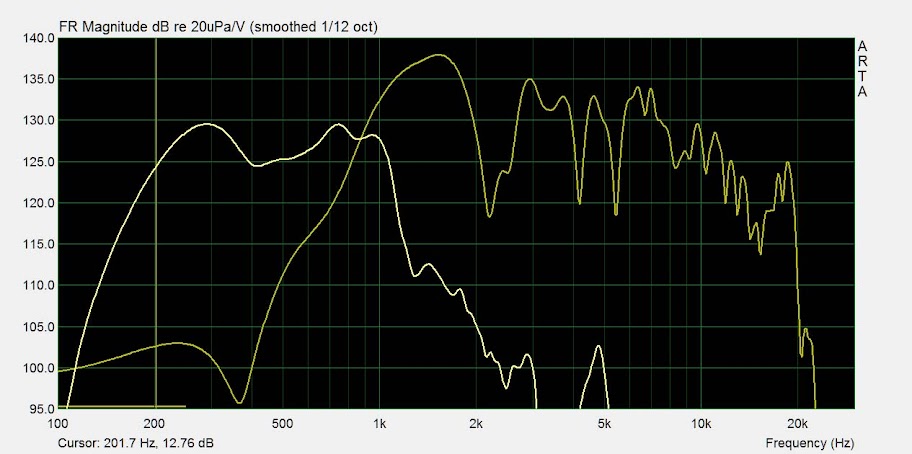
Here's the eq'd response with 4th order LR xo at 1khz:
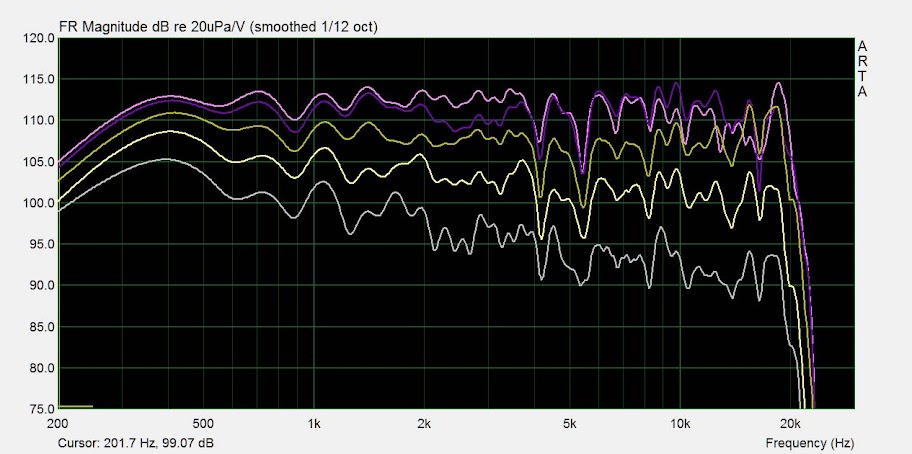
I've got my work cut out for me for sure! Is there any way to model the mid ports for the Paraline? I tried before but I don't see how I would account for the Paraline and the horn shell as Horn Response only allows for one expansion.
Mid response/no eq 4ms gate about 6ft distance:

I'm looking for about 250-1.5khz bandwidth on the mids, not bad for the first shot. I figured I'd hit the 1.5k but would be lacking on the low end. Gotta work on the ports.
Comp driver response/no eq 4ms gate:

Pretty ugly! After all my testing I wasn't expecting a straight line but I'm not liking those deep nulls around 5k either. I tested the comp driver on the horn with the mid port counterbores duct taped over with polyfill in the c-bore and got a much better response. I suppose the sound reflects off the mid cone differently than it does duct tape! I'm actually getting more hf extension out of the cd with the mids mounted as opposed to the duct tape.
This is the drivers no eq measured at the horn mouth to pick up the low end of the mids. Never mind the level mismatch, that's the volume setting on my amp.

Here's the eq'd response with 4th order LR xo at 1khz:

I've got my work cut out for me for sure! Is there any way to model the mid ports for the Paraline? I tried before but I don't see how I would account for the Paraline and the horn shell as Horn Response only allows for one expansion.
Still at it...........thought I'd try modifying the mid ports to get more extension at the top end. As a starting point, I made the mid ports slotted at .25" wide and about .5" long. They follow the radius of a 4.25" circle with its center at the comp driver center. In reality the port center is about 2.2" from CD center. The frustrums are 2" dia .375" deep in .5" mdf. Here's a drawing:
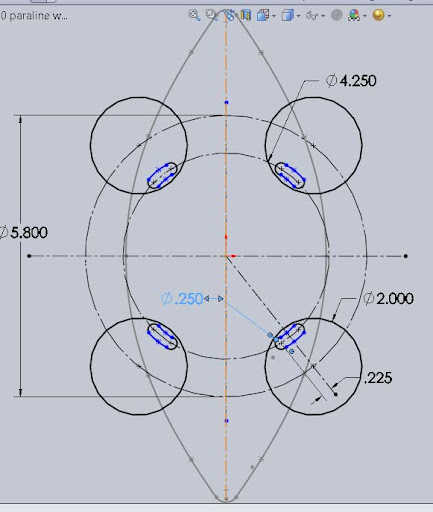
I read through the massive "Midrange cone for a Unity" thread (again) while I was at work today, hoping to pick up some ideas for the ports. I figured it'd be easiest to start by making the frustrums smaller. To do that, I set a bottle with 1.5" dia in the counterbore over the port and filled the extra space in the c-bore with plummer's putty. Pull the bottle out and I now have a 1.5" dia frustrum. Do that x 4.
Before I did that, I took a baseline measurement a couple inches from the horn mouth, no gating. After the port mod and another measurement I was surprised to see virtually no change in output. Nada. In the graph yellow represents the baseline with the 2" frustrum, and pink is the new 1.5" dia frustrum:
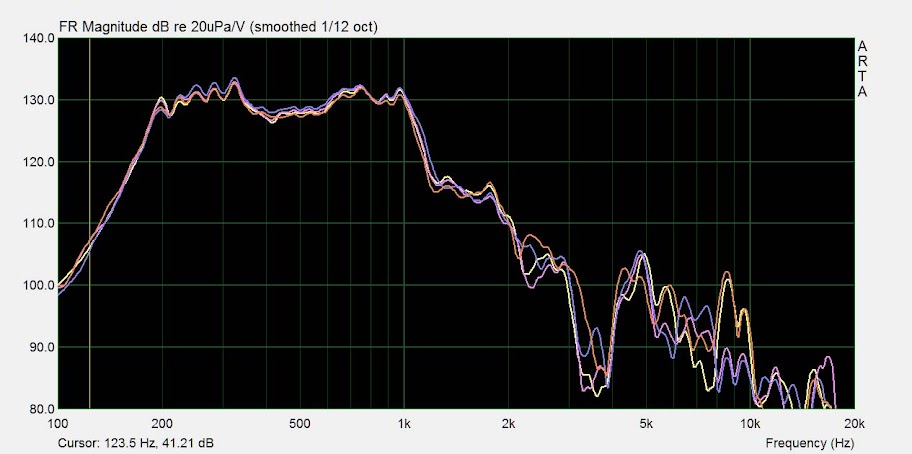
Next I thought I'd enlarge the port. After removing the putty I changed the width from .25" to .35" and it's maybe .05" longer. Not a huge amount but I was expecting some change for sure. Nope. Well, a touch louder but that's it. The measurement here is the blue curve.
I pulled the drivers off again, and used a 1" dowel over the ports with my putty trick to make 1" dia frustrums to go with the larger ports. Still little to no change, this one's the orange curve.
I just realized that I've been using 2.2" as the distance from the mid ports to the center of the comp driver. Looking at my drawing in 2d this makes sense. BUT, I'm using a BMS 4524 cd, which has a 1" long spacer between the diaphragm and the screen on the exit, which obviously adds an inch to my 2.2". I got this cd because of that spacer (and its' small magnet) to allow me to position the mids as close to the cd as I could. The 1khz cutoff on the mids makes sense now. 1/4 wl of 3.2" is a little over 1 khz. 1/2 wl cancellation explains the first notch a little over 2khz. The main cancellation short of 4k corresponds roughly with the wl of 3.2" (I'll take everything apart and measure to see what my 3.2" estimate actually is).
So, if my thinking is right, it's behaving exactly as it should and I would have been better off with a beefier 1" comp driver that's more comfortable at 1k. It looks like a couple of the neo BMS 1" drivers would allow me to get closer spacing on the mids and be a more stout driver to boot. I think I'll optimize the system with my 4524s for a 1k xo right now, I live in an apartment and doubt I'll be playing them loud enough to stress them anyways. Gotta say I am quite surprised that the port mods didn't make any change to the response. I'm sure the larger ports are more detrimental to the cd though..........
and I would have been better off with a beefier 1" comp driver that's more comfortable at 1k. It looks like a couple of the neo BMS 1" drivers would allow me to get closer spacing on the mids and be a more stout driver to boot. I think I'll optimize the system with my 4524s for a 1k xo right now, I live in an apartment and doubt I'll be playing them loud enough to stress them anyways. Gotta say I am quite surprised that the port mods didn't make any change to the response. I'm sure the larger ports are more detrimental to the cd though..........

I read through the massive "Midrange cone for a Unity" thread (again) while I was at work today, hoping to pick up some ideas for the ports. I figured it'd be easiest to start by making the frustrums smaller. To do that, I set a bottle with 1.5" dia in the counterbore over the port and filled the extra space in the c-bore with plummer's putty. Pull the bottle out and I now have a 1.5" dia frustrum. Do that x 4.
Before I did that, I took a baseline measurement a couple inches from the horn mouth, no gating. After the port mod and another measurement I was surprised to see virtually no change in output. Nada. In the graph yellow represents the baseline with the 2" frustrum, and pink is the new 1.5" dia frustrum:

Next I thought I'd enlarge the port. After removing the putty I changed the width from .25" to .35" and it's maybe .05" longer. Not a huge amount but I was expecting some change for sure. Nope. Well, a touch louder but that's it. The measurement here is the blue curve.
I pulled the drivers off again, and used a 1" dowel over the ports with my putty trick to make 1" dia frustrums to go with the larger ports. Still little to no change, this one's the orange curve.
I just realized that I've been using 2.2" as the distance from the mid ports to the center of the comp driver. Looking at my drawing in 2d this makes sense. BUT, I'm using a BMS 4524 cd, which has a 1" long spacer between the diaphragm and the screen on the exit, which obviously adds an inch to my 2.2". I got this cd because of that spacer (and its' small magnet) to allow me to position the mids as close to the cd as I could. The 1khz cutoff on the mids makes sense now. 1/4 wl of 3.2" is a little over 1 khz. 1/2 wl cancellation explains the first notch a little over 2khz. The main cancellation short of 4k corresponds roughly with the wl of 3.2" (I'll take everything apart and measure to see what my 3.2" estimate actually is).
So, if my thinking is right, it's behaving exactly as it should
I haven't read enough on unity horns and acoustic bandpass yet. But going on the assumption that it's the path length difference from the most distant part of the cone that causes the cancellation, could you e.g. angle them to help equalize the pathlength through the port? There are a few ways to then reduce the extra volume created.
Hard to cut perhaps, but it would be easy to experiment with putty/cardboard.
Hard to cut perhaps, but it would be easy to experiment with putty/cardboard.
- Home
- Loudspeakers
- Multi-Way
- Square Pegs